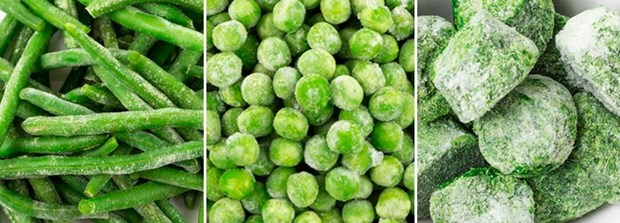A closer look at cryo-blanching, a rapid freezing method capable of preserving the color and flavor of green vegetables. Discover its secrets.
At
this time of the year, I imagine your freezer is full of excellent veggies
frozen during summer for using them when required. So, you already know that,
generally speaking, when you cook them you will be reminded of all the bright
colours and flavours of summer, even though the consistency will be rather
disappointing.
I
can explain this better with an example: green beans that have just been thawed
look inviting enough but if you touch them, they feel limp. If you toss them in
the pan they will taste better, but nothing like the results obtainable from a
fresh product.
What is
cryo-blanching?
For
this reason, the two chefs Alex Talbot and AKi Kamozawa have perfected a
freezing technique called cryo-blanching which is based on a principle
particularly dear to science: extreme cold has more or less the same effects on
organic substances as extreme heat.
In
cooking, however, there is a substantial difference. When we “sear” food, we
rapidly take it to a high temperature but the freezing process takes much
longer. This is the crux of the matter. Basically, freezing leads to the
formation of ice crystals that break down the cell walls of vegetables, making
them soft. If this process is slow, the crystals that form are very large and
actually “rupture” the walls.
For
this reason, we need to aim at a very rapid freezing process, which allows for
the formation of small sharp ice crystals which merely puncture the cells
walls, weakening them sufficiently to make our vegetables soft, but leaving
them with a pleasing consistency. Then, when we go to cook them equally
rapidly, the resulting vegetables will be brightly coloured and tasty.

Frozen green beans, peas and spinach.
The rules of
cryo-blanching
In
the cryo-blanching technique, freezing is all important. So, it is worthwhile
learning how to do it properly.
1.
Freeze in small quantities.
If we pack a large quantity of our delicious dwarf beans, to quote the example
above, they will take a long time to freeze, especially those in the centre of
the “bundle” we have thrown into the freezer. To avoid this, it is preferable
to arrange them in a single layer, neatly arranged. Don’t worry about how much
space you take up: the volume is the same and if you do it in an orderly
fashion you will actually save space. Besides, this tip also explains why the
“family-size bags” of industrially frozen vegetables never come up to
expectations. You are better off freezing them yourself!
2.
Always use vegetables with a small cross-section. The larger they are, the longer
they will take to freeze and this would take us back to square one. For this
reason, the best vegetables to use for cryo-blanching are green beans,
asparagus, peas and spinach. Once your vegetables are perfectly frozen, five or
six hours later to be on the safe side, remove and repack them in a zipper-lock
freezer bag, squeeze out any excess air and seal, before returning them to the
freezer. You can store them like this for several months.
3.
When the time comes to use your vegetables, cook them directly from frozen. The rapid transition from a low to
a high temperature preserves most of their original flavour and aroma. Do
remember, however, to use a very high temperature so that the water they expel
evaporates quickly and prevents the product from overboiling.
Vegetables
cooked in this way can be used in your favourite recipes but you may even dare
to serve them just as they are, as if fresh. If not for the fact that fresh
beans are not easy to come by in the middle of winter, it would be hard to tell
the difference.
By FDL